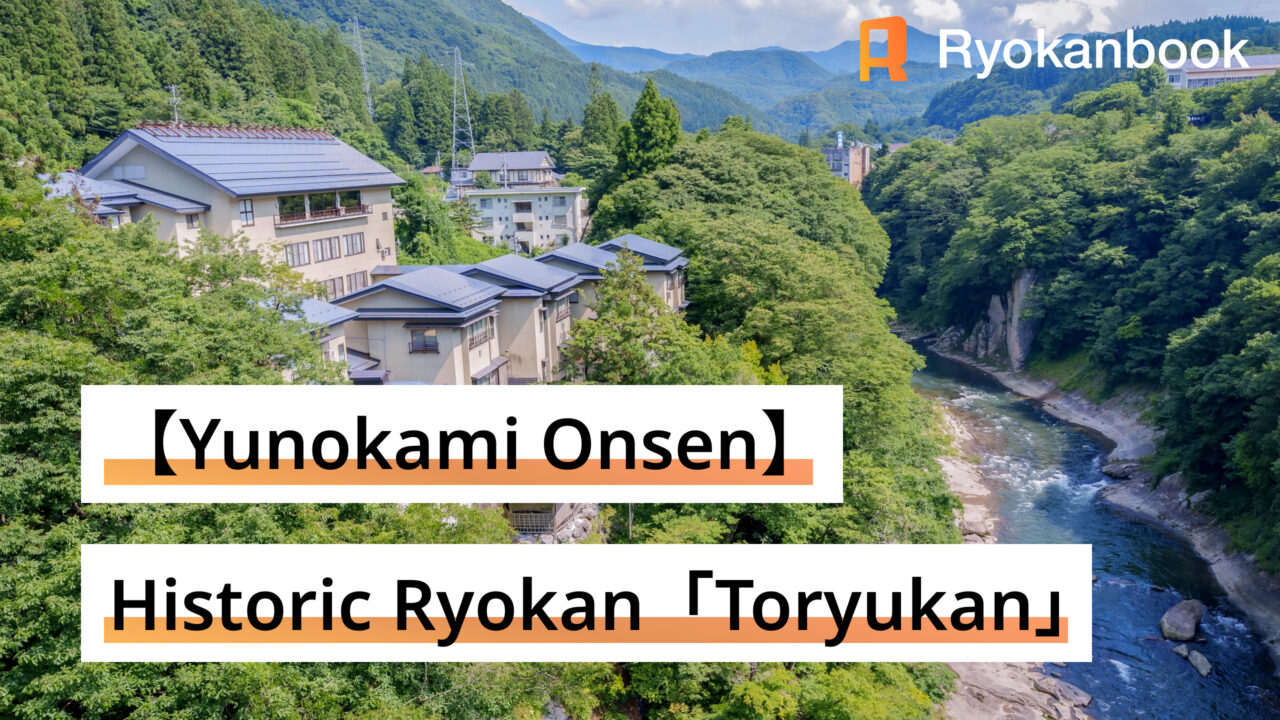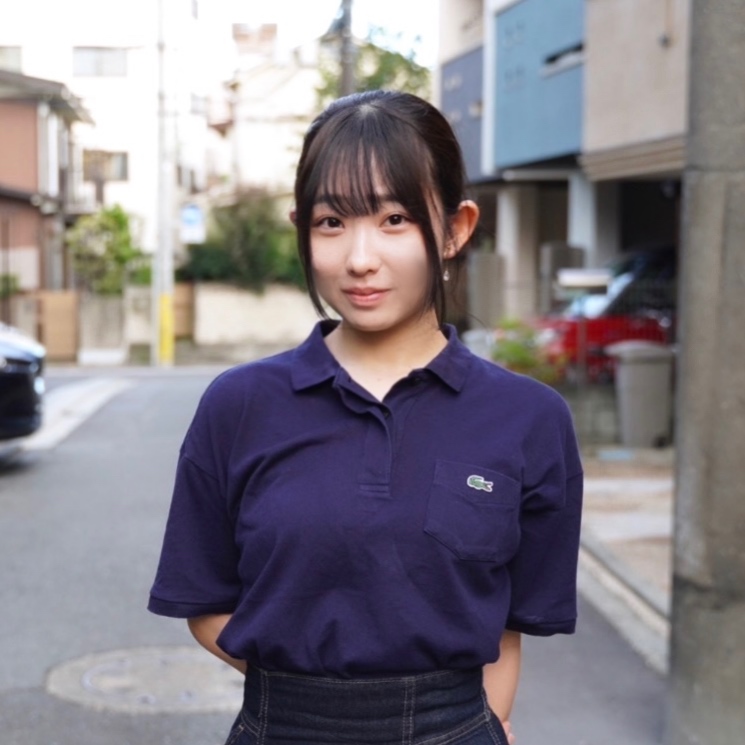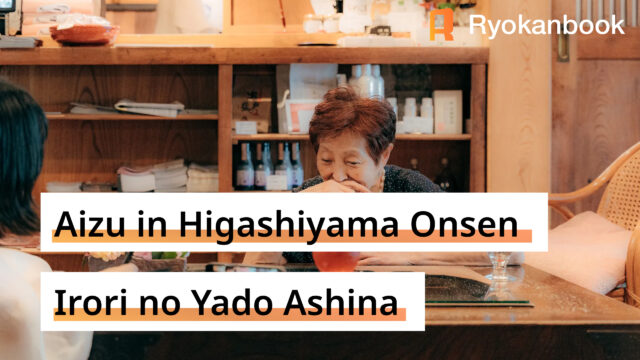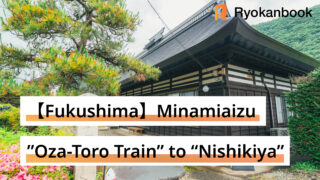Do you know about Yunokami Onsen?
It’s a peaceful hot spring village that has been loved for generations as a place of healing.
For me, it’s more than just a travel destination — it’s my hometown.
This time, I’ll be sharing about Toryukan, a long-established ryokan that represents the heart of Yunokami Onsen.
Hi my name is Aoi! I was born and raised in Fukushima. My family runs a Ryokan( traditional japanese inn) , so I grew up surrounded by ryokan life.
With this article, I hope to introduce the unique charm of Fukushima and the deep-rooted ryokan culture that I truly cherish.
▷View more details about this Ryokan
- Prologue: The Hidden Joy of Staying at a Ryokan — A Cultural Experience Beyond Famous Destinations
- Check-in: Experiencing the Heart of Japanese Hospitality
- [Inside the Ryokan] Surprisingly Modern Comfort for a Long-Established
- Hitomi-san’s (the hostess of the ryokan) Philosophy of Hospitality
- Guest Rooms: Preserving the Tradition of Private Baths
- Public Bath: A Different Atmosphere from the Guest Rooms
- Private Dinner: A Memorable Culinary Experience with Aizu Ingredients
- Breakfast — A Gentle Start to the Morning
- 【Choosing Aizu Souvenirs】Akabeko, Aizu Cotton, and Lacquer Chopsticks
- Summary: Some experiences can only be found through a stay at a traditional ryokan
Prologue: The Hidden Joy of Staying at a Ryokan — A Cultural Experience Beyond Famous Destinations
When you hear the name Fukushima, you might not immediately picture it as a travel destination.
For many visitors, a “typical Japan trip” often means eating monjayaki in Tokyo’s Asakusa or strolling through the bamboo forests of Kyoto’s Higashiyama.
(In fact, even school trips from Fukushima often follow that same route — I went on one myself as a student!)
But what I want to share today is something that offers just as deep a taste of Japanese culture as those well-known spots — the unique experience of staying at a ryokan, a traditional Japanese inn.
A ryokan stay offers many charms: soaking in soothing hot springs, experiencing heartfelt hospitality, and simply slowing down to enjoy the present moment.
Among all these delights, however, there’s one aspect I hope you’ll pay special attention to — the food, which is perhaps the most vivid way to experience the essence of “wa”, or Japanese harmony.
Few people outside Japan know this, but my home region, the Aizu area of Fukushima Prefecture, is filled with culinary traditions deeply rooted in its rich history and culture.
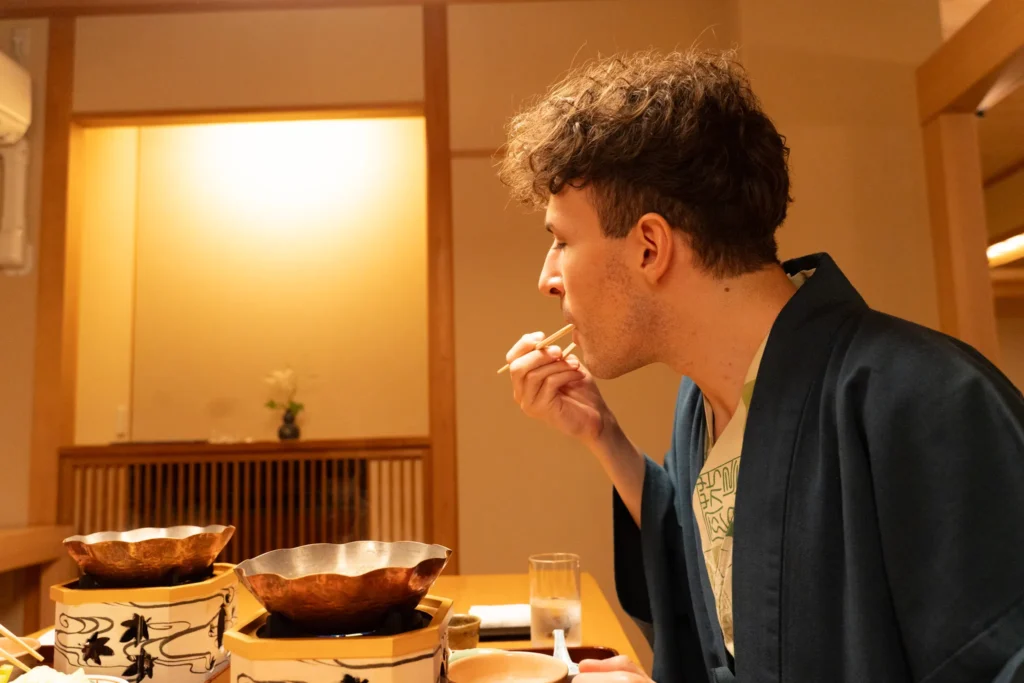
In the Aizu region of Fukushima, known for its deep-rooted food culture, there is a hidden gem — a culinary ryokan called Toryukan.
Run by owner Mr. Hoshi Nagashige, this long-established inn is beloved by those who truly appreciate fine Japanese cuisine.
Mr. Hoshi says,
“While using local ingredients from Aizu, I want to serve authentic Japanese cuisine — to express its depth and spirit through every dish.”
Guided by this philosophy, he continues to craft dishes that highlight the freshness of local ingredients and the subtle harmony of traditional Japanese flavors.
With the unwavering love that Mr. and Mrs. Hoshi holds for their hometown, and the 135 years of history and hospitality that the ryokan carries, Tōryūkan embodies the very soul of Aizu.
In this article, I’d like to share my special experience staying at this remarkable ryokan — a place where tradition, flavor, and heartfelt omotenashi( hospitality) come together in perfect harmony.
Check-in: Experiencing the Heart of Japanese Hospitality
At around 3:00 p.m., I arrived at Toryukan, my accommodation for the night.
As I stepped through the entrance, I was warmly greeted by Hitomi-san, the gracious okami (the hostess of the ryokan) of the ryokan.
“Welcome. You must be tired from your journey,”
she said softly, kneeling in the traditional seiza style — sitting formally on her knees — to welcome me at the entrance.
In that moment, I felt a genuine sense of warmth and gratitude.
It’s rare to see such a gesture in modern Japan, yet it perfectly reflects the spirit of omotenashi, the deeply rooted Japanese approach to hospitality that conveys,
“We honor you, and we welcome you with all our heart.”
Even as times change, moments like this remind me that the feeling of “this is truly special” — that quiet appreciation of kindness and respect — remains universal.
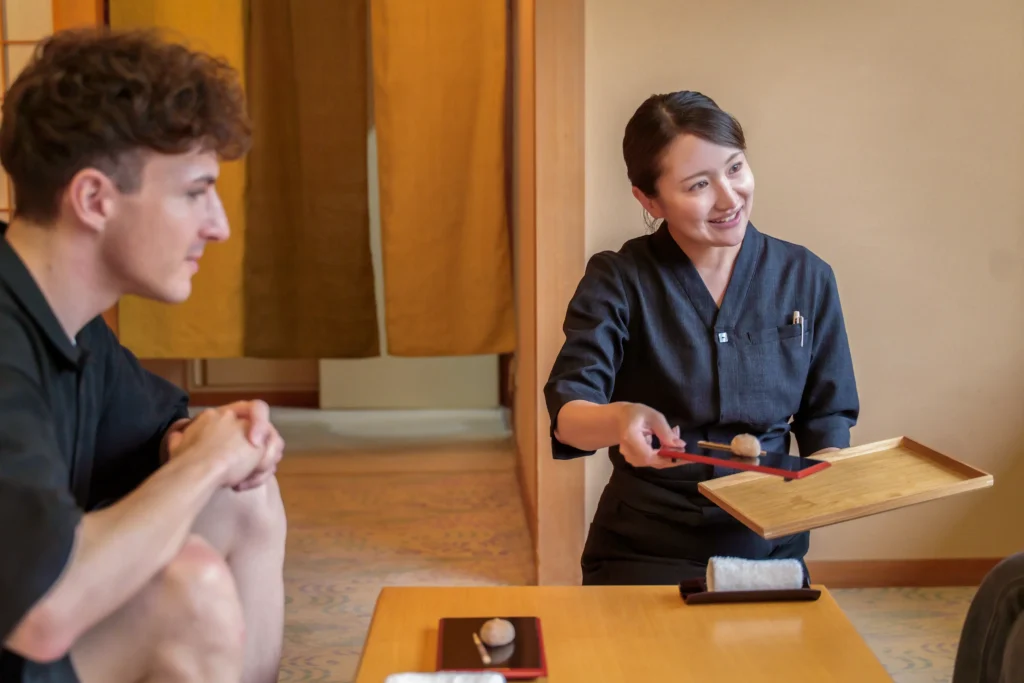
As a welcome drink, we were served Toryukan’s signature sweet, “Mochitsuki Usagi” — soft rice cakes covered in roasted soybean powder (kinako) — along with a bowl of warm matcha green tea.
The hostess told me that the tea was prepared by the senior okami, who is actually a certified Urasenke tea master — one of the main styles of Japanese tea ceremony. There’s even a tea room in the ryokan, where guests can experience authentic matcha prepared in the traditional way.
Unlike the sweet, milk-based “matcha drinks” found in convenience stores, tea ceremony matcha is made by grinding specially grown tea leaves with a traditional stone mill, creating a pure, delicate powder. Its natural sweetness, fragrance, and subtle bitterness offer a completely different experience.
The soft kinako mochi paired perfectly with the gentle flavor of matcha — a blissful combination for anyone with a sweet tooth like me. It was the perfect start to my stay at Toryukan.
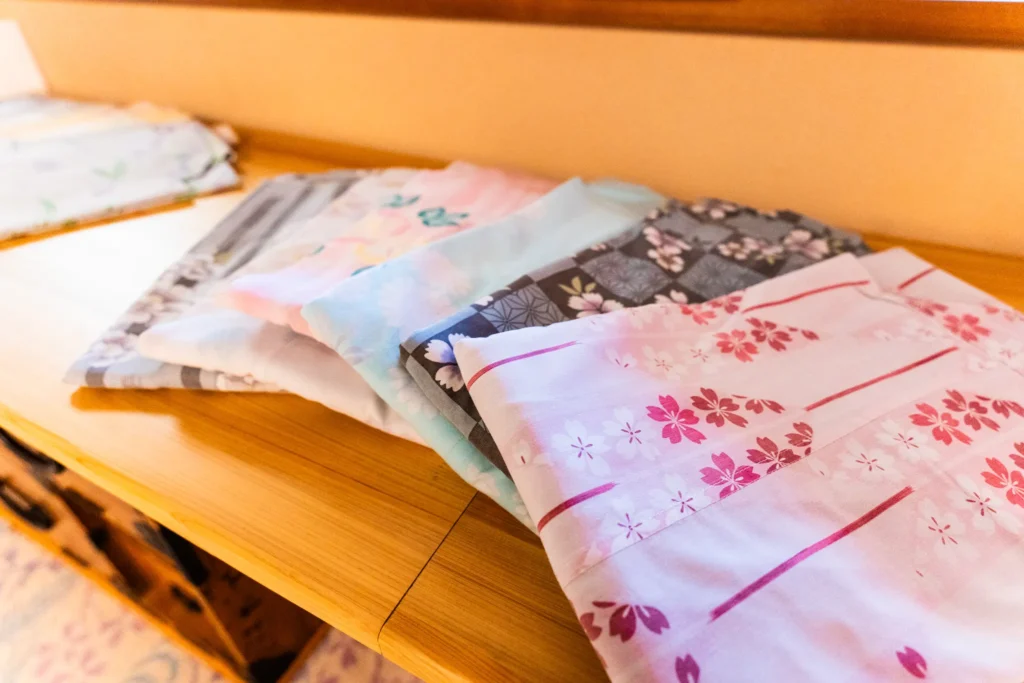
What makes the stay even more delightful is that female guests can choose a colorful yukata (light cotton kimono) for free.
Just walking around the ryokan in your favorite pattern instantly lifts your mood.
Wearing a yukata makes the whole stay feel more festive — it’s one of my favorite parts of the ryokan experience.
[Inside the Ryokan] Surprisingly Modern Comfort for a Long-Established
RyokanWhen people hear the word “long-established,” they sometimes imagine an old building that might feel a bit inconvenient.
But Toryukan is quite the opposite — with only 12 guest rooms, the ryokan feels spacious and beautifully maintained.
There’s even an elevator, and every corner is spotless, allowing guests to relax in total comfort while still surrounded by tradition.
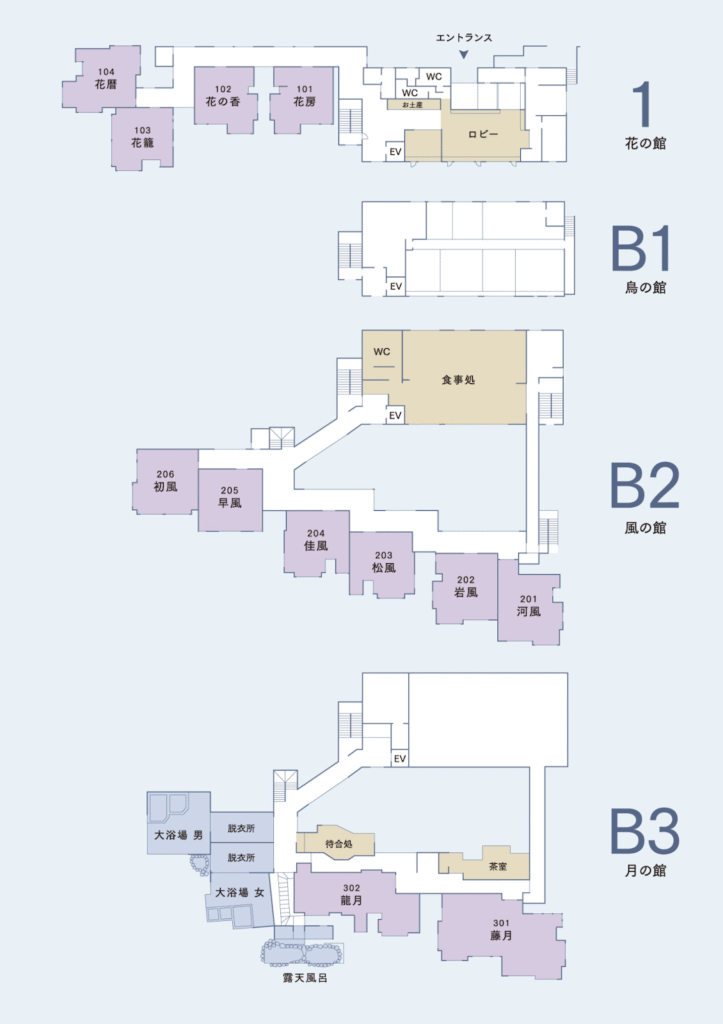
Reference: Official HP:https://www.touryukan.com/facility/
The entrance and lobby are located on the first floor.
If you walk around the charming courtyard, you can take the elevator down to the third basement level.
This unique layout adds a sense of little adventure to your stay — exploring Toryukan feels like a small, delightful journey in itself.
Hitomi-san’s (the hostess of the ryokan) Philosophy of Hospitality
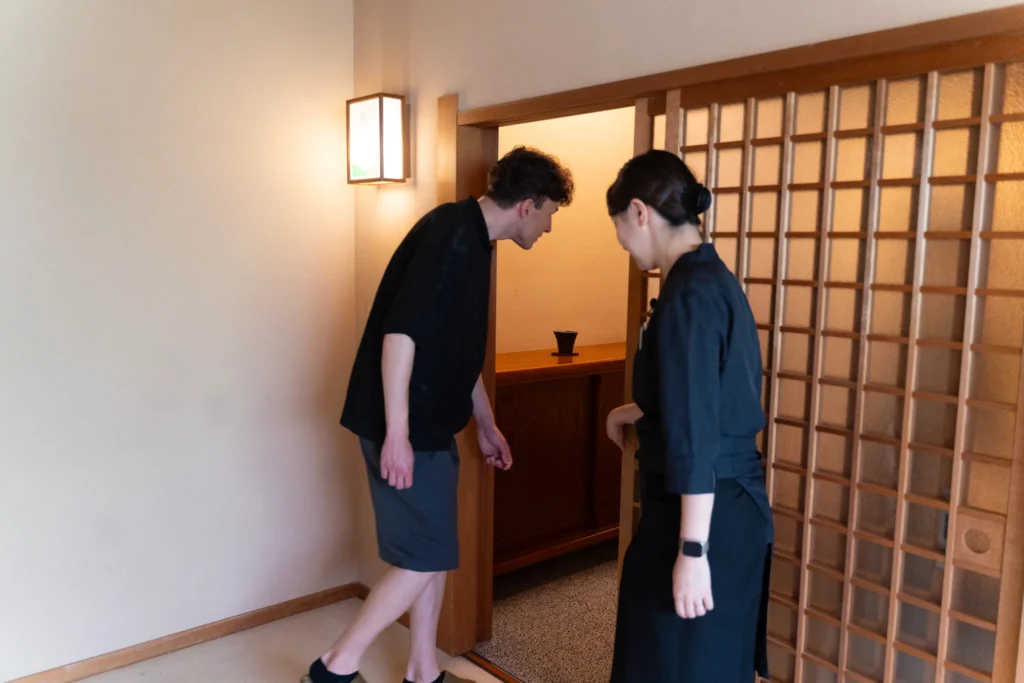
While touring the ryokan, there was one conversation with Hitomi-san that left a particularly strong impression on me. It truly reflected her personal philosophy of hospitality, so I want to share it here.
Aoi:
“We’ve only just arrived, but I already feel so comfortable — the hospitality here is amazing. When you interact with guests, what do you focus on the most?”
Hitomi-san:
“Well, I always try to imagine why they chose our ryokan and how they want to spend their time.
For example, maybe they want to enjoy a relaxing hot spring with a baby, or perhaps they’re seeking a rare escape from work and parenting.
By imagining their needs, I hope I can provide a slightly special experience that suits each guest.”
Aoi:
“That’s wonderful. Is there a reason why you prioritize this kind of hospitality?”
Hitomi-san:
“I think everyone comes here seeking a break from everyday life — a special, extraordinary experience.
If I can at least meet that expectation in one small way, it can make their stay truly memorable. That’s why I focus on hospitality.”
Hitomi-san doesn’t just provide polite service at the moment; she considers the guest’s entire journey and tries to anticipate what will make their experience special.
It’s this deep thoughtfulness and genuine care that, I believe, is the source of the comfort and warmth I felt throughout my stay.
Guest Rooms: Preserving the Tradition of Private Baths
At Toryukan, all 12 guest rooms come equipped with their own private baths.
For those who feel uneasy about large public baths, or who want to enjoy the hot springs without worrying about tattoos, having a bath in your room is a major advantage.
What’s more, these baths are filled with luxurious, free-flowing hot spring water directly from the source (gensen kakenagashi).
In fact, very few ryokans across Japan offer a private, all-rooms-onsen with direct-flow hot spring water. There’s a deep reason behind this.
Having grown up in a hot spring inn myself, I truly appreciate how challenging it is to maintain private baths in every room and how precious it is to provide water directly from the source.
Mr. Shige Nagashige, the owner of Toryukan, explained:
“Our predecessors poured incredible effort into bringing the hot spring water here. That’s why we feel it’s our responsibility to continue preserving this tradition of private baths that has been passed down through generations.”
Knowing this, soaking in the bath doesn’t feel like just bathing — it feels like experiencing the culture of Yunokami Onsen itself, a moment that connects you to the history and tradition of the region.
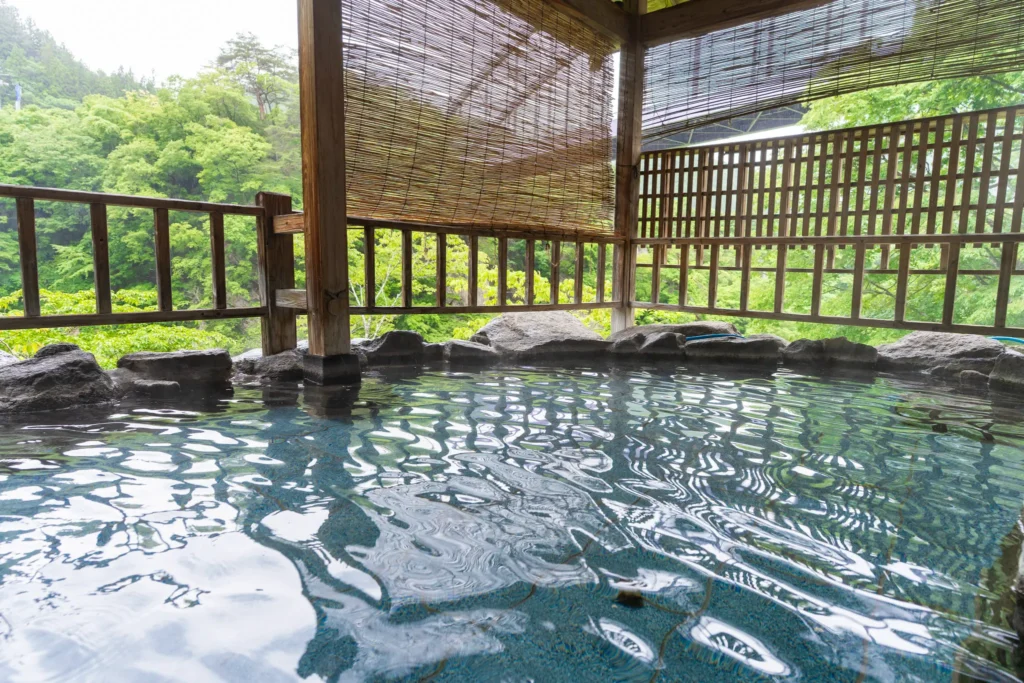
In the special rooms, “Fuzuki” and “Ryutsuki”, guests can enjoy their own private open-air baths overlooking the picturesque valley.
Soaking in the warm water, you are treated to breathtaking views of the valley, adorned by the colors of Japan’s changing seasons.
Having this serene, private space to fully immerse yourself in nature and hot springs is a truly indulgent experience — perfectly worthy of the “special room” designation.

The guest rooms are beautifully designed to highlight the charm of traditional Aizu architecture, giving the feeling of staying in a private villa rather than a typical ryokan.
At the entrance, a tea-scented incense burner gently fills the air, while the desk features playful touches of Japanese culture, such as origami and a shogi set.
Every detail reflects the refined hospitality and heartfelt care that are unique to Toryukan, creating a stay that feels both special and deeply thoughtful.
Public Bath: A Different Atmosphere from the Guest Rooms
Public bath:朧月(Oboro-zuki)・満月(Mangetsu)
Oborozuki: Women’s Public Bath

Mangetsu: Men’s Public bath
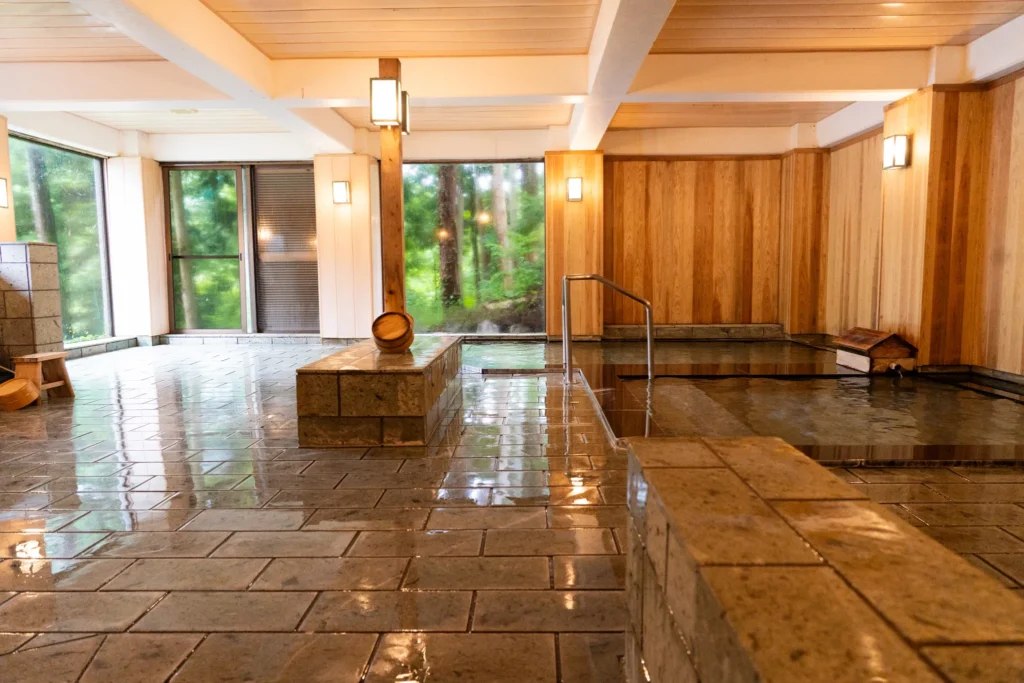
At Toryukan, guests can enjoy three types of baths: the public bath, private open-air baths, and in-room baths (both indoor and outdoor).
The hot spring water at Yunokami Onsen is mildly alkaline, almost neutral, making it gentle on the skin.
It’s known as a “beauty bath”, leaving the skin soft and smooth. Having grown up bathing in these waters, I still often receive compliments from friends on my skin — a testament to the rejuvenating quality of this natural hot spring.
Private Open-Air Baths: 繊月(Sengetsu)・三日月(Mikazuki)
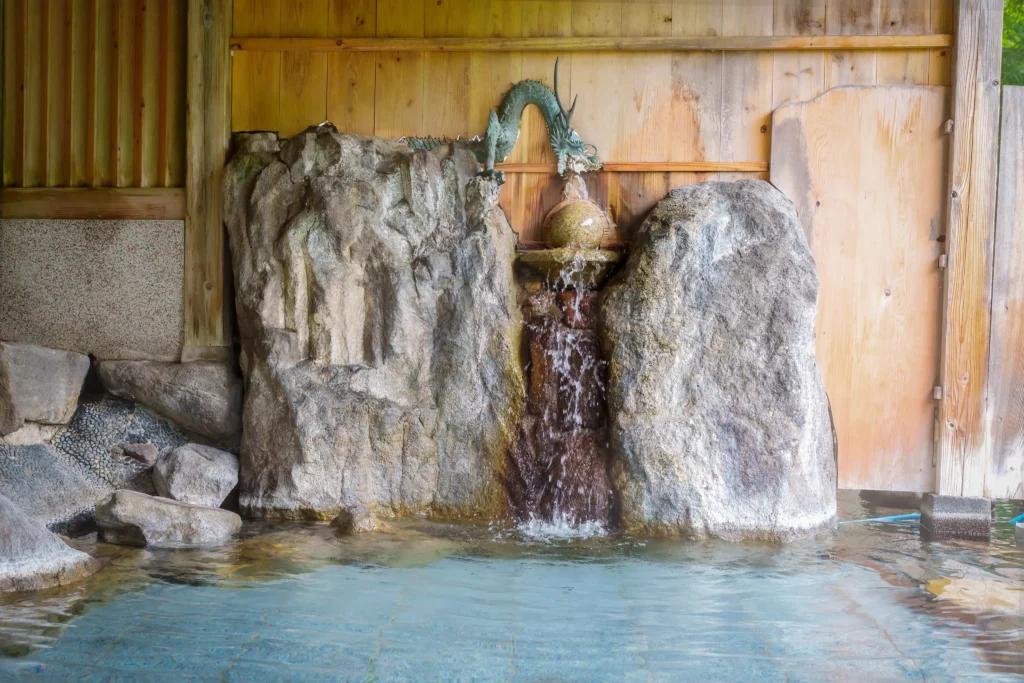
Toryukan also offers two private open-air baths that can be used without a reservation.
Both baths feature open-air tubs with stunning views of the surrounding valley, allowing guests to fully relax while enjoying nature.
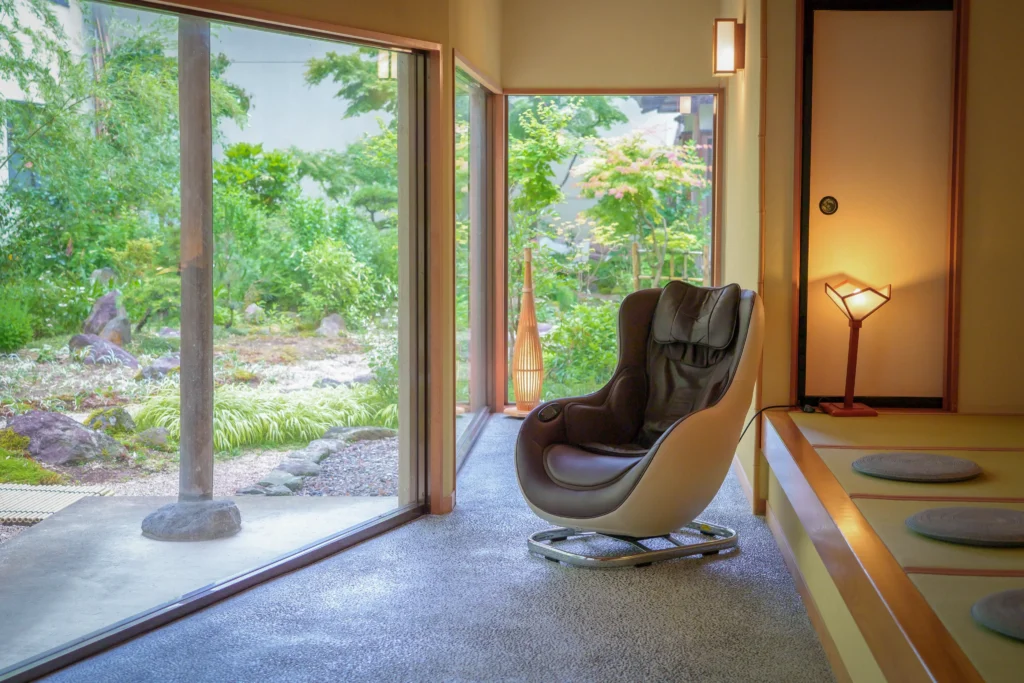
Even better, the use of these baths is included in the room rate, so there’s no additional charge — a delightful bonus for a stress-free experience.
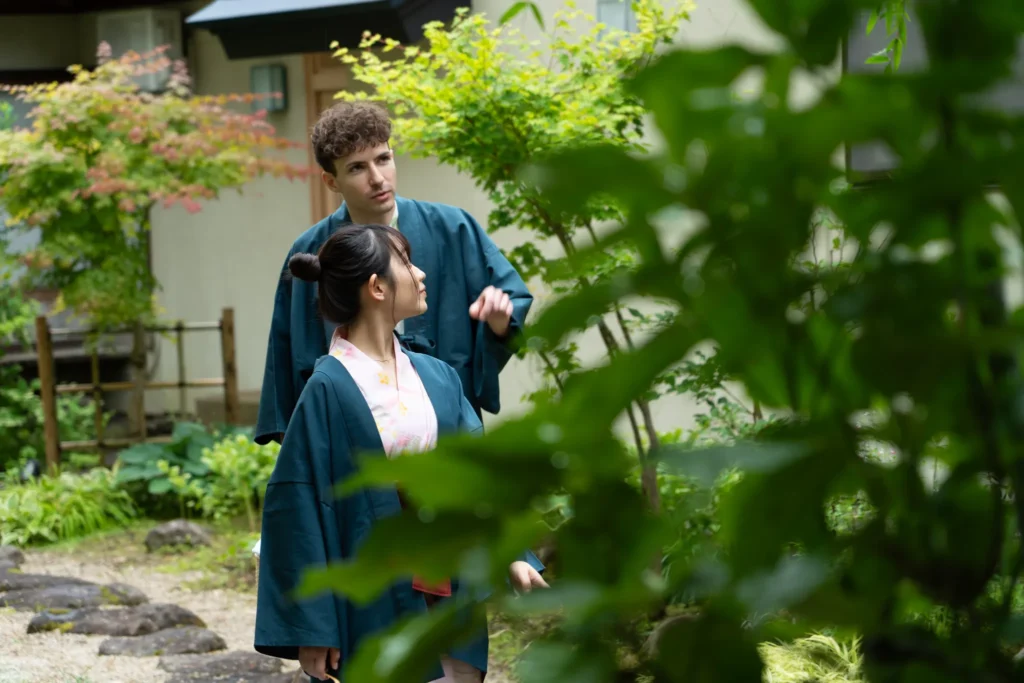
After soaking in the bath, I recommend spending some time at the rest area “Noborizuki”, where you can enjoy peaceful views of the surrounding greenery.
Here, guests can enjoy the delicious water from Minamiaizu and truly unwind, making it the perfect way to extend the relaxing experience after bathing.
After relaxing in the rest area, I took a stroll through the garden just outside, where the fresh greenery was absolutely beautiful.
The cool, refreshing air of the garden felt incredibly soothing on my skin, still warm from the bath, making the experience even more rejuvenating.
Private Dinner: A Memorable Culinary Experience with Aizu Ingredients
First and foremost, I want to emphasize that this was not just a meal — it was a true culinary experience.
Each dish was innovative yet deeply rooted in cultural tradition, leaving a lasting impression that I can recall vividly even now.
I hope to convey that sense of wonder and delight as faithfully as possible through my words.
With that in mind, I would like to share this extraordinary dining experience with you.
Respect for Local Ingredients and Culture

We toasted with “Sharaku” (Sharakku), a junmai ginjo sake (Japanese sake) crafted by the local Aizu brewery、 Miyaizumi Meijo.
This sake, made from Aizu’s pristine water and rice, is served as part of Toryukan’s unique hospitality — a gesture that honors the region’s food and cultural traditions.
When I noticed water droplets on the lid of my soup bowl, I asked Hitomi-san about it. She explained:
“This shows that no one has touched it and no poison has been added.”
I was surprised by the answer, but also deeply moved by the subtle attention to detail and care embedded in Japanese culture.
Japanese culture is often called a “culture of the heart”, where even the smallest gestures carry wisdom and thoughtfulness passed down through generations.
Three Remarkable Dishes That Left Me Amazed
At Toryukan, each season brings a carefully crafted culinary experience.
During my stay, I enjoyed the “Summer Day Menu”, designed to evoke a sense of coolness and seasonal charm.
Among the dishes, three in particular stood out for their creativity and flavor, leaving a lasting impression on my heart.
First Dish — “Seiryu Tofu” with Junsai and Unsen:
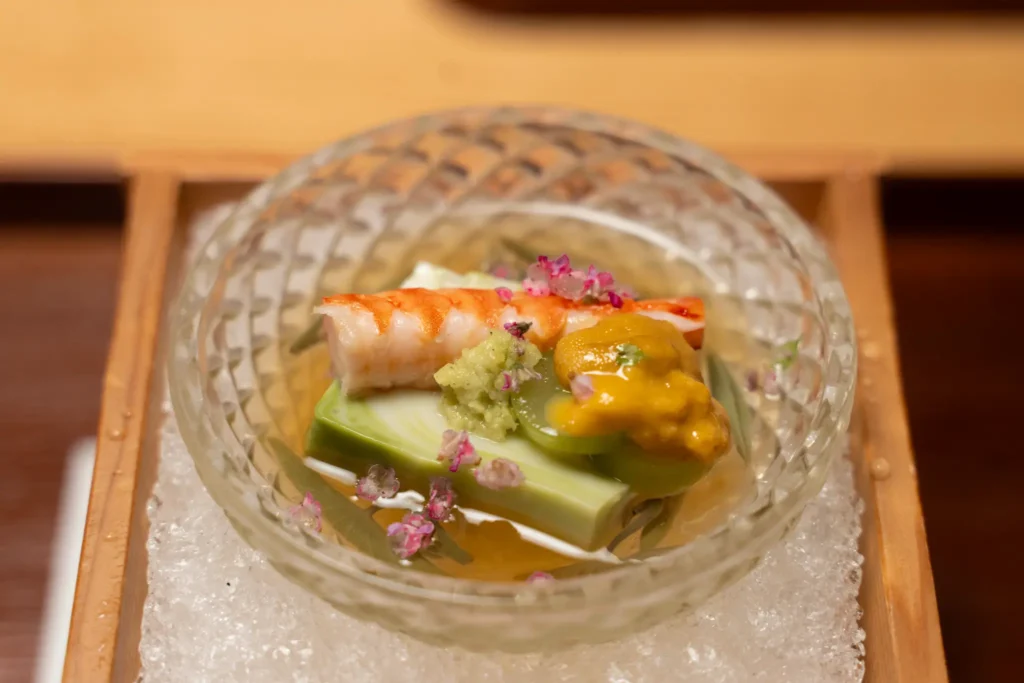
A chilled tofu dish inspired by the clarity of a mountain stream, served with slippery junsai and a light, elegant garnish.
This beautifully presented dish is inspired by the clear summer streams of the Okawa River. It comes covered with a white kaji leaf, traditionally used for writing wishes during Japan’s Tanabata (Star Festival). When you gently lift the leaf, a refreshing green tofu called “Seiryu Tofu” (“Clear Stream Tofu”) appears.
The tofu is made from sesame and lightly flavored with matcha (green tea). It is topped with sweet shrimp, rich sea urchin, and a slice of muscat grape, creating a perfect balance of ocean and land flavors.
A cool, jelly-like dashi broth with junsai (watershield — a small aquatic plant) surrounds the tofu, and crushed ice is placed underneath to keep everything chilled until the very last bite.
This dish feels just like tasting a summer stream — refreshing, elegant, and unforgettable.
Second Course: “Mako Karei” (Marbled Flounder) and “Katsuo Kombu-jime”
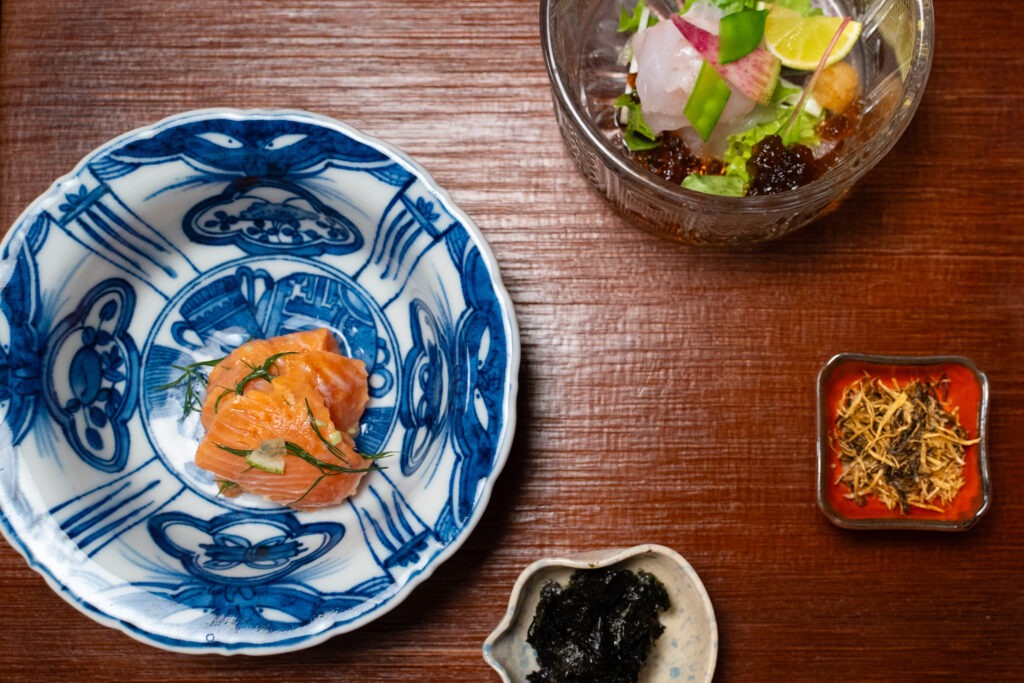
This course offers four refreshing tastes of summer — from kombu-marinated bonito to flounder salad with ponzu jelly, each dish light and full of seaside flavor.
This course is served as four small plates, each capturing a different taste of summer.
First, try the Shimogō-raised rainbow trout dressed with lime — simple, light, and refreshing. Then, add a spoonful of “shimeshi nori”, seaweed from the Ariake Sea mixed with soy-based dashi sauce, and you’ll discover a new layer of umami that lingers beautifully.
On a clear glass plate lies a salad of mako karei (marbled flounder), paired with ponzu jelly, grated daikon with chili, and a touch of sudachi citrus. Mix them to your liking for a bright, tangy finish.
The hostess recommends adding crispy fried kombu and burdock chips on top — their aroma and crunch bring a luxurious accent to the dish. For an extra surprise, try combining all four small dishes together; each flavor harmonizes elegantly, revealing the chef’s delicate touch and mastery of balance.
Third Course: “Fukushima Beef Shabu-shabu”

A warm and comforting dish featuring thinly sliced premium Fukushima beef, lightly swished in hot broth to bring out its tenderness and rich flavor.
The highlight of the meal is this luxurious A5-grade Fukushima beef shabu-shabu. The hostess herself demonstrates the perfect way to cook it — gently swishing the thin slices of beef in hot broth for just 10 to 15 seconds. This brief dip allows the marbling to melt slightly, creating a buttery, melt-in-your-mouth texture.
For aroma, a touch of simmered sansho pepper is added. The hostess recommends enjoying your first bite with only the sansho — no sauce — to fully savor the beef’s natural flavor. Its tender richness spreads softly across your palate, leaving you in a blissful, lingering aftertaste.
Reflections on Dinner at Toryukan
Each dish at Toryukan was prepared with the precision of a traditional ryotei (Japanese fine dining), using local ingredients that reminded me of the pride of being born and raised in Fukushima.
While the safety of Fukushima’s produce is fully guaranteed by the government, some people may still associate the region with the earthquake and nuclear disaster. That is why the cuisine at Toryukan feels especially meaningful — it carries a quiet yet powerful message: to share the true value and beauty of Aizu and Fukushima with the world through authentic local flavors.
What left the deepest impression, however, was the heartfelt hospitality of the hostess and her team. Their genuine warmth elevated every dish and made the entire dining experience feel truly special — from the very first course to the last.
Breakfast — A Gentle Start to the Morning
At 8 a.m., still wrapped in the lingering memories of last night’s dreamlike dinner, I made my way to the breakfast table. The meal began with a cup of steaming hot tea and a comforting dish made from a whole grapefruit. Its bright citrus aroma gently awakened my senses and refreshed my body for the new day.
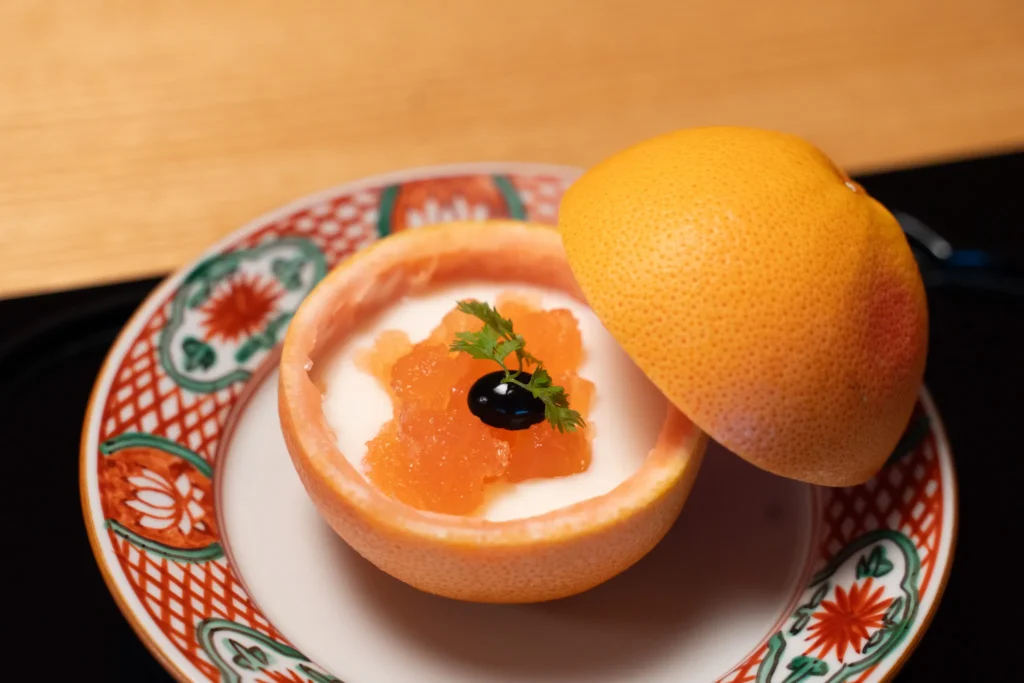
The Colorful “Hakkaku Jubako” — A Three-Tiered Breakfast Box
Next came a glossy black-lacquered octagonal box, known as a hakkaku jubako. As I gently lifted each of the three layers, I was greeted with one delightful surprise after another — a feast for both the eyes and the palate.
Here, I’ll introduce the first and second tiers, which were especially impressive.
First Dish: A Treasure Box of Grilled Delights

The top layer of the jubako features a fragrant assortment of grilled items. At the center is grilled gindara (black cod) marinated in Saikyo miso. After being soaked in the sweet Kyoto-style miso for ten days, the fish is perfectly infused with deep flavor — rich, mellow, and slightly sweet, melting gently in the mouth.
In front sits a small serving of nattō isobe, a unique combination of fermented soybeans wrapped in seaweed. Though unusual, the balance between the sea’s aroma and the creamy texture of the nattō makes it an unexpectedly delightful morning treat.
Another highlight is the grilled nagaimo (Japanese yam), slowly cooked over low heat to bring out its natural sweetness and fluffy texture — truly irresistible once you start.
On the side, a small dish of simmered soybeans and kombu seaweed adds a comforting touch, its gentle umami flavor complementing the grilled dishes beautifully.
Second Dish: A World of Small Dishes Filled with Seasonal Delights
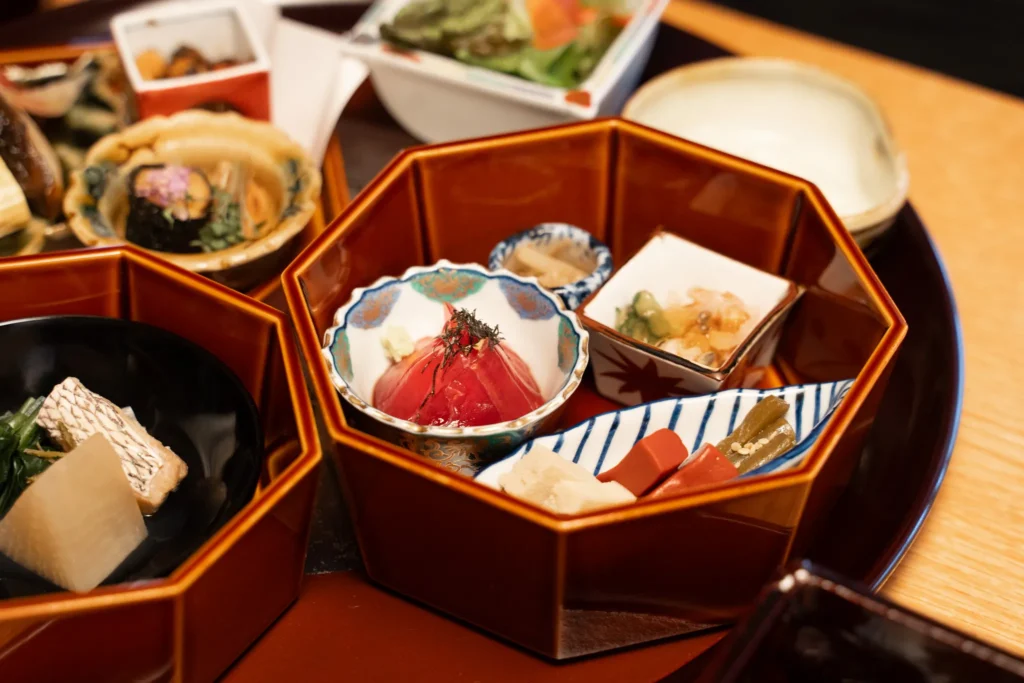
The second layer is a feast for the eyes — a beautifully arranged assortment of seasonal delicacies, like a miniature Japanese garden.
One dish features Shiga’s specialty red konnyaku, simmered together with green beans and koya tofu (freeze-dried tofu). The contrast between the soft, flavorful tofu and the chewy texture of the konnyaku makes it both comforting and fun to eat.
On the left sits steamed squid topped with Tosazu jelly, a light vinegar-based gelée. The cool, tangy flavor enhances the squid’s natural sweetness — a perfect refreshment for summer mornings. Next to it is marinated tuna, rich and umami-packed, with a surprising twist: a layer of avocado tartar sauce hidden underneath, adding a playful Western accent.
Inside a small blue ceramic pot is kinpira made with udo (mountain vegetable). Its crisp texture, gentle bitterness, and slightly spicy seasoning awaken the senses — a delightful way to start the day.
【Choosing Aizu Souvenirs】Akabeko, Aizu Cotton, and Lacquer Chopsticks
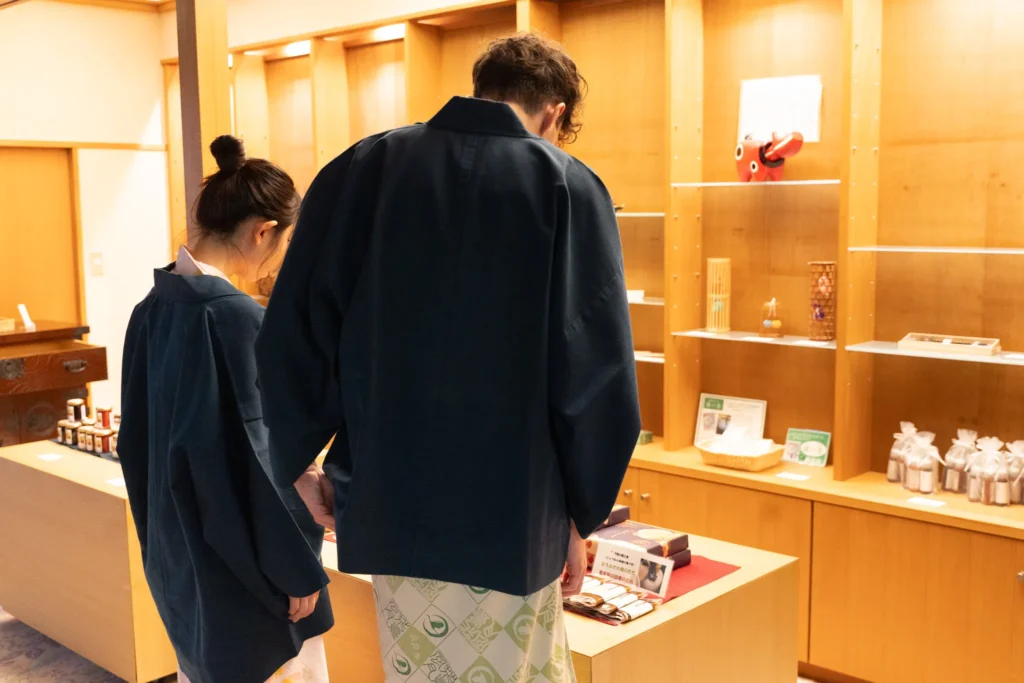
Until checkout time, I enjoyed browsing for souvenirs. At the hotel’s gift shop, I came across Akabeko, a traditional toy from Aizu, Fukushima. In the Aizu dialect, “beko” means cow. This red papier-mâché cow, with its gently bobbing head, is irresistibly charming — a perfect keepsake from the trip.
Other delightful finds included small accessories made of Aizu cotton, lacquered chopsticks handcrafted by young artisans from Meshimoriyama Studio, the hotel’s original “Fuji no Ka” soap made with hot spring water, and the truffle soy sauce served over rice at breakfast — an unforgettable flavor worth taking home.
You can also purchase
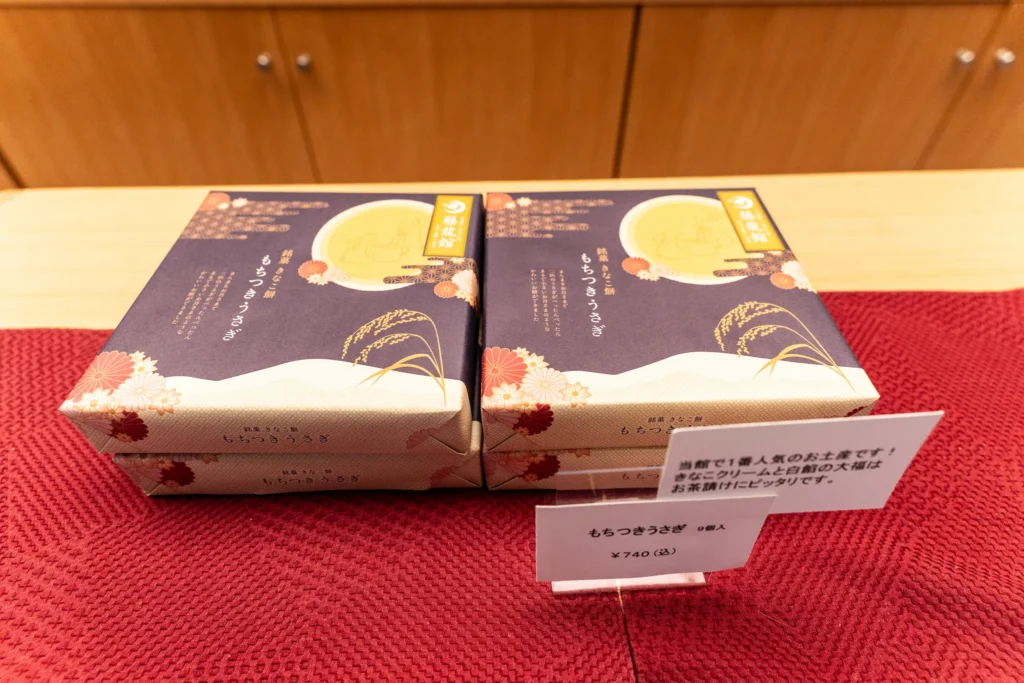
Toryukan’s original confection, “Mochitsuki Usagi” (Rice-Pounding Rabbit). Its gentle sweetness, created from roasted soybean flour (kinako) and smooth white bean paste, has made it the inn’s most popular treat. I first tried it with the welcome drink and immediately became a fan—so of course, I bought some to take home as souvenirs.
Summary: Some experiences can only be found through a stay at a traditional ryokan
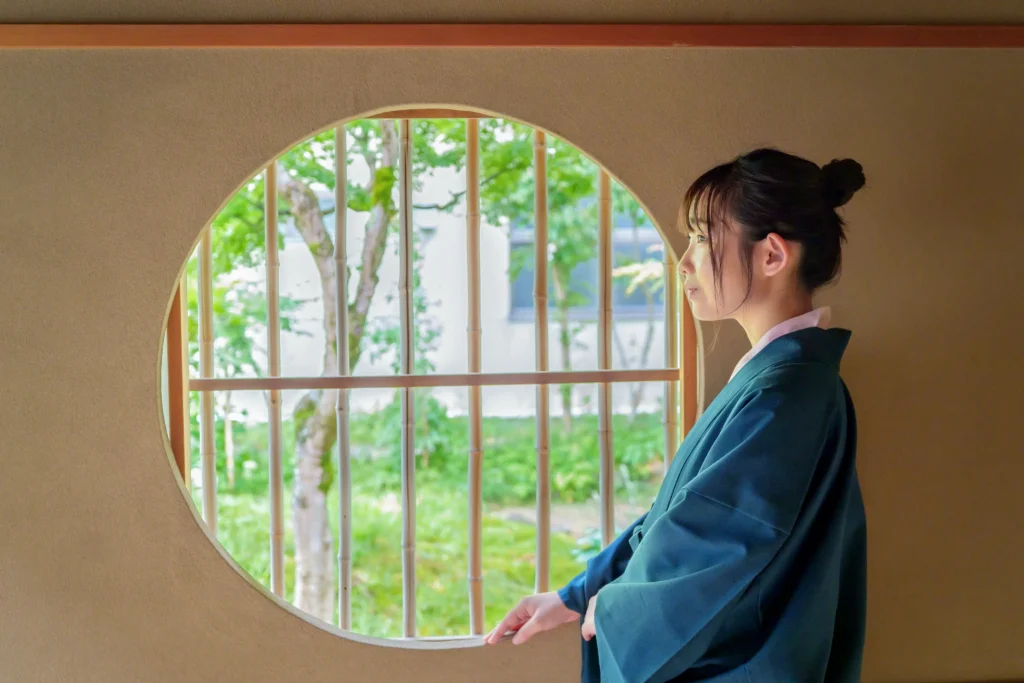
Nowadays, more and more accommodations, such as hotels and private rental houses, exist where “staying overnight” itself is the main purpose. Yet, places like traditional ryokan and minshuku, which accompany guests throughout an entire day with heartfelt care, are still relatively unknown.
Even if they cannot compete with city hotels in terms of convenience or accessibility, regional ryokan carry generations of time, thought, and tradition within their walls. The depth and warmth of this hospitality cannot be captured by the word “stay” alone. That is why I hope visitors will not simply sleep here, but truly experience and enjoy a ryokan stay.
Tōryūkan is a long-established culinary ryokan proudly standing in Aizu, where every moment is infused with care and pride. A stay here is sure to make your trip a truly special and unforgettable memory.
Spot:Toryukan
Address: 1338 Yunosho, Tatehon Otsu, Shimogo-machi, Minamiaizu-gun, Fukushima 969-5206, Japan
Google Maps Link
Access:
By Train:
- From JR Shin-Shirakawa Station → Free shuttle bus to Fujiryukan (approx. 1 hour, reservation required by the day before)
- From Asakusa → Limited Express Liberty Aizu to Aizu-Tajima Station → Aizu Railway to Yunokami Onsen Station → 10-minute walk
By Car:
- From Shirakawa IC → Route 289 Kashi Road
(Route 37 Hatoriko Line is not recommended due to many curves.) - From JR Fukushima Station → approx. 2 hours by car
- From Koriyama IC on the Tohoku Expressway → approx. 1 hour by car

